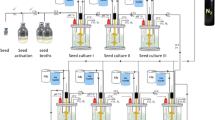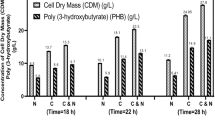Abstract
Organic acids are produced as by-product in food waste by acid fermentation process for biogas production. Particularly, butyric acid is one of the main organic acids and can be converted to n-butanol via the butyrate kinase pathway. However, bacterial toxicity of butyric acid limits its use as a major carbon source. Here, we produced n-butanol from butyric acid using Clsotrdium beijerinckii KCTC 2203, which was the most suitable strain among the six Clostridia strains tested. We produced up to 9.84 g/L of n-butanol using a mixed carbon source composed of 25 g/L of glucose and 10 g/L of butyric acid in a flask culture. The pH-stat fed-batch fermentation method was also performed to increase the production rate. To maximize the effect of pH-stat feeding, substrate feeding solutions with various butyrate/glucose (B/G) ratios were fed. As a result, 9.69 g/L of n-butanol could be produced at a B/G ratio of 0.5, and the pH-stat fed-batch feeding strategy exhibited an enhanced n-butanol production rate of 0.40 g/L/hr without substrate depletion. Finally, we integrated this method with gas stripping using the volatility of n-butanol to prevent product inhibition, resulting in the production of 41.27 g/L of n-butanol in 124 h.






Similar content being viewed by others
References
Edwards, R., Beziat, J.C., Larivé, J.F.: Well-to-wheels Analysis of Future Automotive Fuels and Powertrains in the European Context Joint Research Centre of the European Commission, EUCAR and CONCAWE Report Version 2a (2011)
Ndaba, B., Chiyanzu, I., Marx, S.: n-Butanol derived from biochemical and chemical routes: a review. Biotechnol. Rep. 8(Supplement C), 1–9 (2015). https://doi.org/10.1016/j.btre.2015.08.001
Sorda, G., Banse, M., Kemfert, C.: An overview of biofuel policies across the world. Energy Policy. 38(11), 6977–6988 (2010). https://doi.org/10.1016/j.enpol.2010.06.066
Ezeji, T., Milne, C., Price, N.D., Blaschek, H.P.: Achievements and perspectives to overcome the poor solvent resistance in acetone and butanol-producing microorganisms. Appl. Microbiol. Biotechnol. 85(6), 1697–1712 (2010). https://doi.org/10.1007/s00253-009-2390-0
Bowles, L.K., Ellefson, W.L.: Effects of butanol on Clostridium acetobutylicum. Appl. Environ. Microbiol. 50(5), 1165–1170 (1985)
Outram, V., Lalander, C.-A., Lee, J.G.M., Davies, E.T., Harvey, A.P.: Applied in situ product recovery in ABE fermentation. Biotechnol. Prog. 33(3), 563–579 (2017). https://doi.org/10.1002/btpr.2446
Patakova, P., Maxa, D., Rychtera, M., Linhova, M., Fribert, P., Muzikova, Z., Lipovsky, J., Paulova, L., Pospisil, M., Sebor, G., Melzoch, K.: Perspectives of Biobutanol Production and Use. In: Bernardes, M.A.d.S. (ed.) Biofuel’s Engineering Process Technology. p. Ch. 11. InTech, Rijeka (2011)
Girotto, F., Alibardi, L., Cossu, R.: Food waste generation and industrial uses: a review. Waste Manag. 45(Supplement C), 32–41 (2015). https://doi.org/10.1016/j.wasman.2015.06.008
Yasin, N.H.M., Mumtaz, T., Hassan, M.A., Abd Rahman, N.A.: Food waste and food processing waste for biohydrogen production: a review. J. Environ. Manag. 130(Supplement C), 375–385 (2013). https://doi.org/10.1016/j.jenvman.2013.09.009
Ntaikou, I., Antonopoulou, G., Lyberatos, G.: Biohydrogen production from biomass and wastes via dark fermentation: a review. Waste Biomass Valoriz. 1(1), 21–39 (2010). https://doi.org/10.1007/s12649-009-9001-2
Shinto, H., Tashiro, Y., Yamashita, M., Kobayashi, G., Sekiguchi, T., Hanai, T., Kuriya, Y., Okamoto, M., Sonomoto, K.: Kinetic modeling and sensitivity analysis of acetone–butanol–ethanol production. J. Biotechnol. 131(1), 45–56 (2007). https://doi.org/10.1016/j.jbiotec.2007.05.005
Martin, J.R., Petitdemange, H., Ballongue, J., Gay, R.: Effects of acetic and butyric acids on solvents production by Clostridium acetobutylicum. Biotech. Lett. 5(2), 89–94 (1983). https://doi.org/10.1007/BF00132165
Gottschal, J.C., Morris, J.G.: The induction of acetone and butanol production in cultures of Clostridium acetobutylicum by elevated concentrations of acetate and butyrate. FEMS Microbiol. Lett. 12(4), 385–389 (1981). https://doi.org/10.1111/j.1574-6968.1981.tb07679.x
Yu, M., Zhang, Y., Tang, I.C., Yang, S.-T.: Metabolic engineering of Clostridium tyrobutyricum for n-butanol production. Metab. Eng. 13(4), 373–382 (2011). https://doi.org/10.1016/j.ymben.2011.04.002
Al-Shorgani, N.K.N., Kalil, M.S., Yusoff, W.M.W., Hamid, A.A.: Impact of pH and butyric acid on butanol production during batch fermentation using a new local isolate of Clostridium acetobutylicum YM1. Saudi J. Biol. Sci. 25(2), 339–348 (2018). https://doi.org/10.1016/j.sjbs.2017.03.020
Kudahettige-Nilsson, R.L., Helmerius, J., Nilsson, R.T., Sjöblom, M., Hodge, D.B., Rova, U.: Biobutanol production by Clostridium acetobutylicum using xylose recovered from birch Kraft black liquor. Biores. Technol. 176, 71–79 (2015). https://doi.org/10.1016/j.biortech.2014.11.012
Tracy, B.P.: Improving butanol fermentation to enter the advanced biofuel market. mBio. 3(6), e00518–e00512 (2012). https://doi.org/10.1128/mBio.00518-12
Moon, H.G., Jang, Y.-S., Cho, C., Lee, J., Binkley, R., Lee, S.Y.: One hundred years of clostridial butanol fermentation. FEMS Microbiol. Lett. 363(3), fnw001–fnw001 (2016). https://doi.org/10.1093/femsle/fnw001
Branduardi, P., Porro, D.: n-butanol: challenges and solutions for shifting natural metabolic pathways into a viable microbial production. FEMS Microbiol. Lett. 363(8), fnw070–fnw070 (2016). https://doi.org/10.1093/femsle/fnw070
Jiang, M., Chen, J., He, A., Wu, H., Kong, X., Liu, J., Yin, C., Chen, W., Chen, P.: Enhanced acetone/butanol/ethanol production by Clostridium beijerinckii IB4 using pH control strategy. Process Biochem. 49(8), 1238–1244 (2014). https://doi.org/10.1016/j.procbio.2014.04.017
Visioli, L.J., Alves, E.A., Trindade, A., Kuhn, R.C., Schwaab, M., Mazutti, M.A.: Evaluation of biobutanol production by Clostridium beijerinckii NRRL B-592 using sweet sorghum as carbon source. Ciência Rural 45, 1707–1712 (2015)
Jones, D.T., Woods, D.R.: Acetone–butanol fermentation revisited. Microbiol. Rev. 50(4), 484–524 (1986)
Soni, B.K., Das, K., Ghose, T.K.: Inhibitory factors involved in acetone-butanol fermentation by Clostridium saccharoperbutylacetonicum. Curr. Microbiol. 16(2), 61–67 (1987). https://doi.org/10.1007/BF01588173
Al-Shorgani, N.K.N., Ali, E., Kalil, M.S., Yusoff, W.M.W.: Bioconversion of butyric acid to butanol by Clostridium saccharoperbutylacetonicum N1-4 (ATCC 13564) in a limited nutrient medium. Bio Energy Res. 5(2), 287–293 (2012). https://doi.org/10.1007/s12155-011-9126-6
Li, T., Yan, Y., He, J.: Reducing cofactors contribute to the increase of butanol production by a wild-type Clostridium sp. strain BOH3. Biores. Technol. 155, 220–228 (2014). https://doi.org/10.1016/j.biortech.2013.12.089
Thorn, G.J., King, J.R., Jabbari, S.: pH-induced gene regulation of solvent production by Clostridium acetobutylicum in continuous culture: Parameter estimation and sporulation modelling. Math. Biosci. 241(2), 149–166 (2013). https://doi.org/10.1016/j.mbs.2012.11.004
Biebl, H.: Comparative investigations of growth and solvent formation in ‘Clostridium saccharoperbutylacetonicum’ DSM 2152 and Clostridium acetobutylicum DSM 792. J. Ind. Microbiol. Biotechnol. 22(2), 115–120 (1999). https://doi.org/10.1038/sj.jim.2900616
Tashiro, Y., Takeda, K., Kobayashi, G., Sonomoto, K., Ishizaki, A., Yoshino, S.: High butanol production by Clostridium saccharoperbutylacetonicum N1-4 in fed-batch culture with pH-Stat continuous butyric acid and glucose feeding method. J. Biosci. Bioeng. 98(4), 263–268 (2004). https://doi.org/10.1016/S1389-1723(04)00279-8
Hüsemann Michael, H.W., Eleftherios, P.T.: Solventogenesis in Clostridium acetobutylicum fermentations related to carboxylic acid and proton concentrations. Biotechnol. Bioeng. 32(7), 843–852 (1988). https://doi.org/10.1002/bit.260320702
Ezeji, T.C., Qureshi, N., Blaschek, H.P.: Acetone butanol ethanol (ABE) production from concentrated substrate: reduction in substrate inhibition by fed-batch technique and product inhibition by gas stripping. Appl. Microbiol. Biotechnol. 63(6), 653–658 (2004). https://doi.org/10.1007/s00253-003-1400-x
Qureshi, N., Blaschek, H.P.: Recovery of butanol from fermentation broth by gas stripping. Renew. Energy. 22(4), 557–564 (2001). https://doi.org/10.1016/S0960-1481(00)00108-7
Acknowledgements
This work was supported by the Korea Institute of Energy Technology Evaluation and Planning (KETEP), the Ministry of Trade, Industry & Energy (MOTIE) of the Republic of Korea (20163010092150) and Korea Institute of Industrial Technology as “International Joint Research Project (JE180010)”.
Author information
Authors and Affiliations
Corresponding author
Rights and permissions
About this article
Cite this article
Lee, DG., Jeon, JM., Yang, YH. et al. The pH-stat Butyric Acid Feeding Strategy Coupled with Gas-Stripping for n-Butanol Production by Clostridium beijerinckii. Waste Biomass Valor 11, 1077–1084 (2020). https://doi.org/10.1007/s12649-018-0461-0
Received:
Accepted:
Published:
Issue Date:
DOI: https://doi.org/10.1007/s12649-018-0461-0




